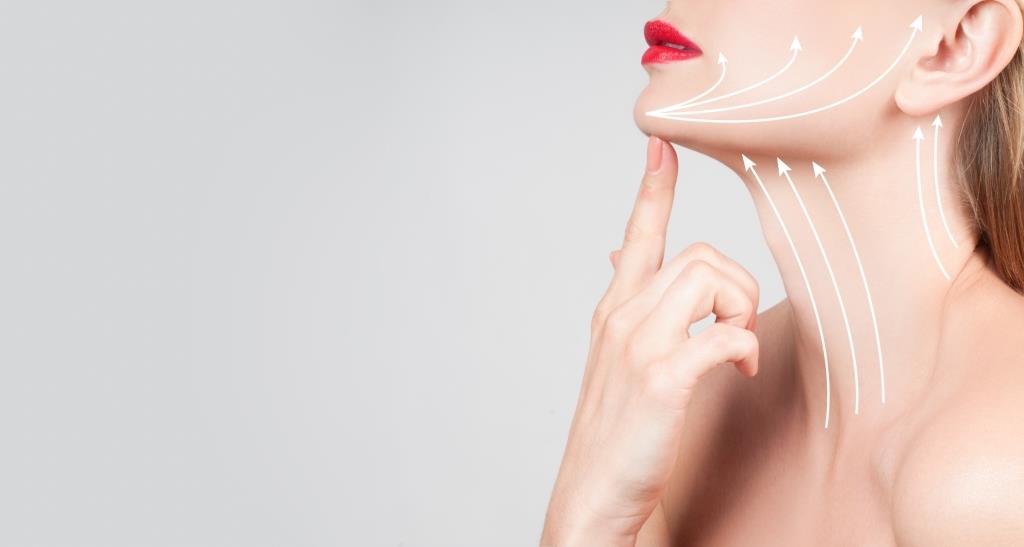
Undefined jawlines and saggy neck skin seem to be the brunt for millions of women. Aging is not the sole cause for them, and surgery is far from the only solution. We talked to Dr. Amelia K. Hausauer about the contributing factors to less-than-perfect jawline and neck and the procedures available.
Outside of aging, what other factors contribute to the jawline and neck losing firmness?
As we age, our skin loses its ability to hold moisture; cell turnover, including the production of collagen and elastic fibers, drops; and fat and bone breakdown, so ultimately there is more sagging, fine lines, wrinkles, and volume loss. Environmental exposures, especially ultraviolet light from the sun, accelerate these processes. Breakdown of these vital skin molecules leads to horizontal lines, aka necklace lines or textural changes. For those who sleep on their sides or backs, creasing and folding of the skin night after night makes the lines in the décolletage and neck deeper. So does looking down at all our smart phones and other devices.
Sun is also largely responsible for unsightly brown spots and tiny blood vessels that are common on the sides of the neck. People don’t do a very good job remembering to protect their necks and chests, so the skin is constantly exposed to these ultraviolet rays without sunscreen as a barrier.
Moreover, there is a muscle called the platysma that covers the neck like a tablecloth and wraps up over the jawline. With time and repeat contraction, that muscle splits, causing vertical bands down the neck, and pulls down, blunting the angle of the jaw. This muscle extends from connective tissue on the face that relaxes over time and further contributes to jowel formation.
The neck area – from saggy neck skin to a jawline that has lost its firm shape, is often hard to correct. What makes this area hard to improve, especially for someone who relies on non-surgical procedures?
This is a hard area to treat for a number of reasons. First, the skin on the neck and chest is thin and does not heal as well as areas on the face, so any resurfacing treatments such as lasers, micro needling, peels, or other devices must be adjusted appropriately.
It is best to see an expert board-certified dermatologist or plastic surgeon for these concerns because the risk of scarring and uneven pigmentation is higher. Because of these risks and the need for advanced training, our practice, Aesthetx, has two surgeons Drs Zeidler and Berkowitz and one fellowship-trained dermatologist who collaborate in order to design the most optimal treatment plan.
Second, there are lots of tiny muscles that interact and play a vital role so detailed understanding of the anatomy is critical. Third, although technology has come a long way, we still don’t have great minimally invasive devices for skin tightening. Ulthera, Thermage and others help but only for a portion of people. Surgery continues to be the gold standard. Lastly, we begin to lose bone mass as we age. The mandible (jawbone) is highly susceptible, especially in women. This means that the foundation underneath our skin, fat, and muscle gets smaller so truly restoring contour means rebuilding lost bone. This is not always an easy feat. The analogy I use with patients is that it’s like a tablecloth on a shrinking table…eventually that cloth will pool and crease.

Many say that neck lift surgery delivers the best results compared to non-surgical intervention. Yet, in what type of cases are non-surgical methods actually preferred?
To reframe excess or sagging skin, surgery still is by far the most effective option. My colleagues do this routinely in our private surgery center with great success. However, surgery will not get rid of surface skin changes such as light and dark spots, redness and blood vessels, cobble-stoning, texture irregularities and fine lines. Lasers help even out the canvas of the skin and erase these superficial changes. It’s a very high-yield treatment that I like to perform either in isolation or in combination with the surgical procedures. Neuromodulators (ie Botox, Xeomin, Dysport) and fillers can also help correct these superficial changes. The skin has memory, so sometimes even after surgery tiny creases remain and injectable procedures can be used to help perfect these or to treat post operative scars after surgery.
Who are the ideal candidates for non-surgical rejuvenation of the neck/jawline rather than a neck lift?
Anyone with good skin integrity. That means if you pinch the skin and it snaps back then it’s healthy and will usually respond well to treatment. Non-surgical rejuvenation is also a great way to slow the gaining process and stave off surgery until a later date. Get a jumpstart. The other group of people who largely benefit regardless of age are those with surface changes—be it pigment irregularities, fine lines or bumpy texture.
What are the differences that separate men from women when it comes to jawline and neck treatments?
Men have much thicker skin in general; thicker collagen bundles. So, their skin ages more slowly and heals more rapidly. Additionally, they tend to have more robust bone structure and resorption begins at later ages. There is some scientific evidence that repeat shaving of the beard also helps with skin rejuvenation. This theory is actually the basis of a treatment called dermaplaning, shaving of the face for exfoliation. However, facial hairs also limit the type of lasers that can be used in these areas given the risk for patchy hair regrowth or bald spots.
What non-surgical neck rejuvenation treatments do you practice? What are the most commonly requested? Do you have a favorite one?
The neck is a common area of concern in our practice. I prefer to do combination treatments to optimize results. Neuromodulators like Botox, Xeomin or Dysport along the vertical bands, horizontal creases or jawline give a subtle but smoothed and lifted appearance that many of my patients appreciate. This can be combined with superficial fillers into deeper grooves. My favorite for this purpose is Belotero because it can be injected into thin skin without blue discoloration and over time integrates evenly into the crevices of the skin.
Kybella is another fabulous addition to our neck arsenal. This injectable solution dissolves fat and is FDA approved for the submental (under chin) region. Forget turtlenecks to hide that double chin. A series of Kybella treatments helps my patients achieve a more chiseled look.
Another underutilized procedure is laser resurfacing to the neck and chest. I love doing this procedure in the operating room to top off a surgical lift. It literally airbrushes away years of environmental exposure, sun damage and superficial aging. I collaborate with my surgeon colleagues so that patients can piggy back on downtime. Intense Pulse Light (IPL) is another popular laser option we like to use to erase pigmentation and blood vessels. For those with more severe sun damage that turned their skin that red-orange color (think perma-tan), I sometimes couple IPL with a vascular laser to get even more dilated vasculature.
What is the typical recovery time after a neck procedure? What should patients do to encourage recovery? Are there any activities they should avoid?
Recovery is highly variable and based on the specific treatment plan. Typically for injectables, downtime is minimal with few restrictions. Filler into fine lines can be bumpy or form ridges for the first week or two, but then settles nicely. Kybella produces quite a bit of non-tender swelling that looks like a bag of water under the chin. This is most pronounced during the first three days but can last two weeks and rarely longer. Each subsequent treatment produces less swelling.
The more aggressive the laser therapy, the longer the downtime. Our Halo laser produces a sunburn like reaction for up to a week. Keeping the skin moist with Vaseline, Aquaphor or another thick ointment encourages faster recovery. IPL usually has less pronounced redness but dark spots turn gray-brown like a chocolate chip cookie then flake off over the course of a week. Our more intense laser options cause true breaks in the skin, so patients have a bit of oozing and crusting during the first seven days. Soaking the skin every 2-3 hours helps sooth and clean. Although the appearance is pretty dramatic and raw, the skin does not hurt and heals rapidly with the most dramatic improvements.
 A visionary and thought leader in the field of minimally invasive aesthetics, Dr. Amelia K. Hausauer is the Director of Dermatology of Aesthetx, a premier plastic surgery and dermatology practice in Northern California.
A visionary and thought leader in the field of minimally invasive aesthetics, Dr. Amelia K. Hausauer is the Director of Dermatology of Aesthetx, a premier plastic surgery and dermatology practice in Northern California.
For more information, visit Dr. Brian A. Levine's social media:

























